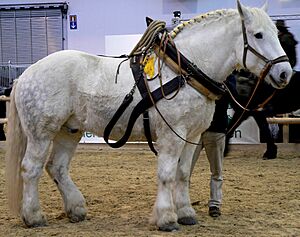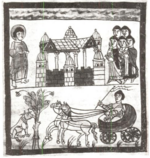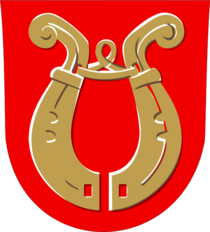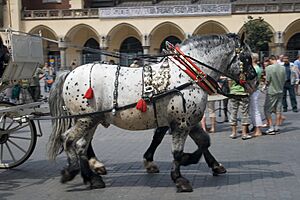Horse collar facts for kids
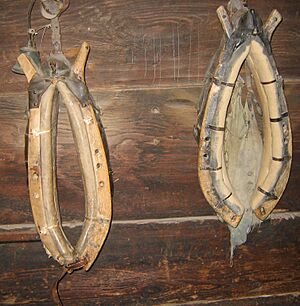
A horse collar is a special part of a horse harness. It helps a horse pull heavy things like wagons or ploughs. The collar goes around the horse's neck and shoulders. It spreads the weight evenly so the horse can pull without hurting itself. Often, the collar has padded parts and curved metal or wooden pieces called hames. The ropes that connect to the wagon, called traces, attach to these hames.
The horse collar lets a horse use its full strength. It allows the horse to push forward with its strong back legs into the collar. Before the horse collar, horses often pulled with their weaker shoulders, or a harness might press on their windpipe. This made it hard for them to breathe and pull at the same time.
When the horse collar was invented, horses became much more useful for farm work. Horses could pull heavier loads and work faster than oxen. They also had more endurance, meaning they could work longer each day. This made horses very important for farming and helped many areas grow and develop. People had more time for other jobs, which led to new industries and towns.
Contents
How a Horse Collar Works
A horse collar is shaped like an oval, not a circle. It's designed to fit a horse's body well. The collar is padded and firm. It's made so that it doesn't press on the horse's airway. This means the horse can breathe easily, even when pulling with all its might. By protecting the horse's windpipe, the animal can use its full power to move heavy loads.
History of Horse Harnesses
Early Harnesses
Old Ways of Pulling
For a long time, people used a less effective harness called the "throat-girth harness." This harness had flat straps across the horse's neck and chest. The load was attached high up, similar to a yoke. When the horse pulled, these straps pressed on its neck muscles and windpipe. This made it hard for the horse to breathe. The harder the horse pulled, the more it choked itself.
Because of this problem, oxen were often used for heavy work instead of horses. Oxen don't have the same breathing issues with this type of harness. However, some experts now believe that ancient harnesses were actually designed better than first thought. They might not have choked the horses as much as once believed.
The Breastcollar Harness
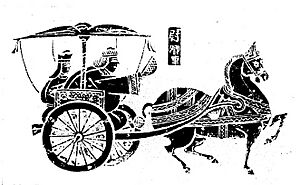
The throat-girth design improved when the "breastcollar" harness was developed in China. This happened during the Warring States period (481–221 BC). This new harness put pressure on the horse's chest bone (sternum). This was much better because the pulling force was linked directly to the horse's skeleton. This allowed the horse to use almost its full strength.
The breastcollar harness became common in China by the Han dynasty (202 BC – 220 AD). It then spread to Central Asia and later to Europe by the 8th century. Even with this improvement, the breastcollar still had a small problem. The main pulling force came from a strap around the horse's middle, not directly from the chest. This meant the horse was still "pulling" the load more than "pushing" it. While better, it wasn't as efficient as the horse collar for very heavy loads.
The Horse Collar in China

The next big step was the invention of the full horse collar. This design finally allowed a horse to use its complete strength. It let the horse push forward with its powerful back legs into the collar. The fully developed horse collar appeared in China during the 5th century AD.
One of the earliest clear pictures of a horse collar is in a cave painting from the Chinese Northern Wei dynasty. This painting, from around 477–499 AD, shows the arched crossbar of the collar. Later paintings, like one from the Sui dynasty around 600 AD, show the horse collar used even for camels. Camels were often used in China from the 2nd century BC.
A famous painting from 851 AD shows the Chinese general Zhang Yichao's victory parade. This picture clearly shows horse collars that are well-padded and fit correctly. They are low on the chest and rise behind the cross-bar, just like modern ones.
The Horse Collar in Europe
The horse collar eventually reached Europe around 920 AD. It became widely used by the 12th century. People in Scandinavia were among the first in Europe to use a horse collar that didn't squeeze the horses' breathing passages. Before this, oxen were still the main animals for farm work. This was because earlier harnesses caused problems for horses.
With the horse collar, horses could work about 50% faster than oxen. They also had more endurance and could work longer hours. Europeans were already used to horses, so it was easy for them to switch from oxen harnesses to the new horse collar.
How the Horse Collar Changed Things
The horse collar removed the old problems that stopped horses from using their full power. Instead of just pulling, the horse could now push its workload. This made their labor much more efficient.
After the horse collar came to Europe around 1000 AD, using horses for plowing became very common. Horses work faster, and with the collar, along with other inventions like the horseshoe and the heavy plow, farmers could produce much more food. This extra food meant that people didn't all have to be farmers. Some could specialize in other jobs, like buying and selling goods. This led to the growth of a merchant class and helped end the feudal system in Europe. The horse collar was a key part of these big changes.
Studies on Pulling Weight
Early in the 20th century, a French officer named Lefebvre des Noëttes studied how much weight horses could pull with different harnesses. In his 1910 experiment, he found that two horses using the old throat-and-girth harness could only pull about 1100 pounds (half a ton). But a single horse with the more efficient collar harness could pull about 1.5 tons!
However, some people questioned these findings. They argued that ancient harnesses might have been better than Lefebvre's tests showed. They believed that with the right design, even older harnesses didn't cut off a horse's air. Later studies in the 1970s, using more accurate copies of ancient harnesses, suggested that horses could pull almost as much with old designs as with modern collars. The main advantage of the modern horse collar, they argued, was that it allowed the pulling point to be lower. This made horses even better for plowing.
See also
- Collar (animal)
- Horse harness
- Draft horse
- Oxbow
- Yoke


